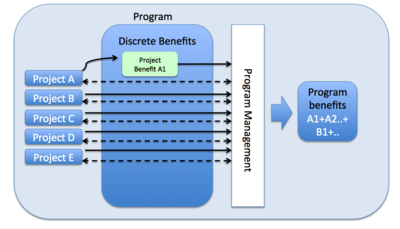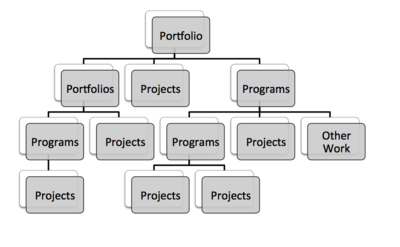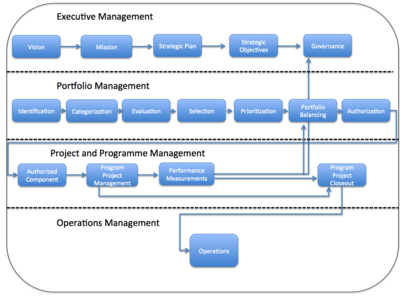Project Portfolio Management Vs. Programme Management
(→Definition) |
(→Definition) |
||
| Line 8: | Line 8: | ||
====Definition==== | ====Definition==== | ||
| − | A standard is in general defined as something considered by an authority or by general consent as a basis of comparison; an approved model<ref name=''http://dictionary.reference.com/browse/standard''> ''http://dictionary.reference.com/browse/standard'' </ref>. According to the International Organisation for Standardization a standard is defined as a document that provides requirements, specifications, guidelines or characteristics that can be used consistently to ensure that materials, products, processes and services are fit for their purpose. | + | A standard is in general defined as something considered by an authority or by general consent as a basis of comparison; an approved model<ref name=''http://dictionary.reference.com/browse/standard''> ''http://dictionary.reference.com/browse/standard'' </ref>. According to the International Organisation for Standardization a standard is defined as a document that provides requirements, specifications, guidelines or characteristics that can be used consistently to ensure that materials, products, processes and services are fit for their purpose. <ref name=''http://www.iso.org''> ''http://www.iso.org'' </ref> |
====International Standards==== | ====International Standards==== | ||
Revision as of 20:48, 1 December 2014
As consequence of globalisation of markets for goods, capital and labor, it became common to use internationally recognised terms in many companies and organisations. Specially in the field of project Management it can be hard to understand the background and relevance of different methods and terms compared to each other. Programme and Project Portfolio Management are often mentioned in the context of the overall topic of Project Management and thereby it can be confusing to understand the differences. The objective of this article is to wrap up distinctions according to existing literature and best practices, by the determination of fundamental key factors and thereby clarify the differences.
Contents |
What is a standard
This section seek to give the reader a understanding of what a standard is. Further it will explain the definition of a standard and how the numerous standard setting organizations (SSO) are related. It is often mentioned that a certain project management method is a standard, which is developed by a specific organisation such as ISO, CCTA or PMI. The clarification of the meaning and relation of those terms can be crucial, in order to understand the overall topic of this article.
Definition
A standard is in general defined as something considered by an authority or by general consent as a basis of comparison; an approved model[1]. According to the International Organisation for Standardization a standard is defined as a document that provides requirements, specifications, guidelines or characteristics that can be used consistently to ensure that materials, products, processes and services are fit for their purpose. [2]
International Standards
Internationally there are many standards organizations. The three mostly established and largest of them are the International Organisation for Standardization (ISO), the International Electrotechnical Comission (IEC), and the International Telecommunication Union (ITU). Both ISO and IEC are composed of national standard bodies. ITU is a treaty based organisation established as permanent agency of the United Nations, were governments are the primary members. In 2001 the World Standards Cooperation was established by the International Electrotechnical Comission (IEC), the International Organisation for Standardization (ISO), and the International Telecommunication Union (ITU). The aim of WSC is to strengthen and advance the voluntary consensus-based International standards systems of IEC, ISO and ITU.
- ISO promotes worldwide proprietary, industrial and commercial standards
- IEC promotes standards for all electrical, electronic and related technologies
- ITU promotes standards for the telecommunication sector
National Standards
National standard bodies are in general existent in each country or economy. These standard bodies may either be public or private sector organizations, or a combination of the two.
Standard in the context of Programme Vs. Project Portfolio Management
Todays most common standards of Programme Management are the approaches of MSP and PMI. In many markets there is a debate about which of the two programme management frameworks should be adopted. An article written by Rod Sowden, lead author for MSP 2007 and 2011, compares MSP and PMI. Sowden concludes that these two methods are surprisingly compatible and build on the strengths and weaknesses of each other rather than proposing opposing approaches. [1] Further Sowden distinguish PMI and MSP as follows:
- PMI has its roots in project management and would be stronger in the specification led type of change.
- The MSP framework is built from the strategic management view and is intended to align with one or more corporate objectives, which are often more ambiguous, which is reflected in the way MSP approaches the challenges.
Since this article is focused on the field of Project Management, it is based on the definitions of the standard for Programme and Portfolio Management of PMI.
Programme Management
Definition
The definition of a Programme is, that a Programme contains a group of related projects which are managed in a coordinated way to obtain benefits and control of the overall outcome. This approach would not be possible by managing these projects individually, without the umbrella of a program. Programmes may include elements of related work (e.g., ongoing operations) outside the scope of the discrete projects in a Programme. [4] When a large project is splittet into multiple related projects with explicit management of the benefits, then the effort becomes a Programme. [4] In General Programme Management is used for the creation of portfolios of projects [8], implementation of strategies [9] and change generation in products, business or ways of working. [10]
The distinction between a Project and a Programme is given by the benefits which a Programme provides over and above those that projects can archive on their own. [10]
Key Factors
The following Key factors are determined throughout the literature and best Practice of Programme Management:
- A Programme contains a group of related projects
- A Programme has a overall benefit which can be measured in terms of return of investments, new capabilities and/or benefit delivery
- Programmes have a Wide Scope which may change to meet benefit expectations of the organisation
- Programme Managers have to expect change
- Leadership style focuses on managing relationships and conflict resolution
- Programme Managers manage Project Managers
- Programme Managers create high level plans providing guidance to projects where detailed plans are created
Project Portfolio Management
Definition
The term Portfolio is widely used throughout many different organisations and has come to represent different meanings. Thus the focus of this article lies on Project Portfolio Management.
The origins of Project Portfolio Management are found in the application of modern portfolio theory to the project selection problem and first mentioned in the work of Markowitz [7] The definition of a Project Portfolio is a collection of projects and/or programs and other work that are grouped together to facilitate effective management of that work to meet strategic business objectives. The Projects or Programs of the portfolio (components) may not necessarily be interdependent or directly related. [1] Project Portfolio Management is defined as a dynamic decision process, which constantly updates and revises active projects. [2] Thus Project Portfolio Management enables the organization to align the Project Portfolio to strategic objectives, thereby approving only the components that directly support business objectives, and considering the portfolio risk as a result of the mix of components in a Project Portfolio at any time. [3]
It is stated that a Project Portfolio most likely is one of the truest measures of an organisation´s intent, direction, and progress. Thereby the organisation can reasonably question components of a Project Portfolio , when they are not alligned to the strategy. [3] Hence, Project Portfolio Management as a dynamic decision making process includes the collection, identification, categorisation, evaluation, selection, balance and review of components according to the organisation´s specific key indicators and the strategic plan.
Key Factors
The following Key factors are determined throughout the literature and best Practice of Project Portfolio Management:
- A portfolio is a collection of projects and/or Programs and/or other work that are grouped together to facilitate effective management of that work to meet strategic business objectives
- The scope of a Portfolio is a business scope, that can change with the strategic goals of the organisation
- Succes is measured by the performance of Portfolio components
- The focus of the Portfolio Management lies within that programs and projects are viewed in priority for resource allocation
- The projects and/or programs may not necessarily be interdependent or directly related
- Project Portfolio Management is a dynamic decision process
- Project Portfolio Management enables the organisation to align the Project Portfolio to strategic objectives
- The portfolio risk is a result of the mix of the components
Interface
This section seek to define the interface between Program and Portfolio Management. The Interface and correlation between Program and Project Portfolio Management may be the reason for confusion when one is trying to understand the differences. The key factors stated in the previous sections should give the reader an idea of the distinction of the terms, which now will be more detailed by the definition of the interface.
It is important to understand the responsibilities according to the different components of a Project Portfolio. As described in the section above about Project Portfolio´s : A project Portfolio is a collection of Projects and/or Programs and/or other work that are grouped together to facilitate effective management of that work to meet strategic business objectives. Thus the role of the Project Portfolio Management is the collection, identification, categorisation, evaluation, selection, balance and review of components. That means that once a component (Project and/or Program) is authorized for the perspective Project Portfolio, it becomes the responsibility of the Program/Project Management to take control of the component and apply the correct management processes to ensure that the work is done effectively and efficiently. It is now the responsibility of the Program/Project Management to monitor planned-to-actual performance (time, budget, resources, quality, and scope) of the component and provide the Project Portfolio Management with consolidated information.[5] This information is used in Portfolio reviews to determine required actions. Program and Project Management may work together with Portfolio Management to determine "go/no go" criteria for proposed and current components, including "termination criteria" (phase gates). Program and Project Management may also work together with Portfolio Mangement in capacity planning by inputting resource requirements (e.g., human resources, financial and physical assets). [11]


